Apr 23, 2016 | advice, coins, commentary, legal
If you have not visited Etsy, you will find a shopping site where you can find unique items that are not available elsewhere. Most of the sellers on Etsy sell handmade designs, vintage items, repurposed vintage items, supplies, and unique low volume goods. It would not be farfetched to call Etsy an Internet craft fair and a neat place to go shopping.
One of the more interesting items on Etsy are coin jewelry. Coin designs are themselves a form of art but can become ordinary when repeated over millions of coins. Take a meaningful design and add it to a bezel, attach it to a pendant, or hammer it into a ring and these artists take the coins to the next level.
Many of these artists will take requests for the type of coin for their creations. Some will even let you send a special coin or a coin they cannot obtain to create your design.
A quick search on Etsy for coin jewelry found over 100,000 different jewelry items including bracelets, rings, earrings, bracelets and more. Aside from the different types of jewelry the artists will also use coins from all around the world including the United States, United Kingdom, Canada, Norway, and more.

Resin ear rings made by InspiringFlowers using Roosevelt dimes

1996 Half Dollar Ring by LuckyLiberty

Hummingbird cut from a Trinidad and Tobago penny by SawArtist
Click on the image to visit artist’s store
Coin jewelry hunters may be unknowingly accessories to a crime. According to an article in The Straits Times, it is illegal to make jewelry using coins from Singapore.
Like many other nations, Singapore takes pride in the art on their coinage. Aside from being their means to promote commerce, they are used to represent their culture and society. However, the Monetary Authority of Singapore (MAS), the Singapore equivalent of the U.S. Treasury Department, has said that under Singapore’s Currency Act, it is illegal to “mutilate, destroy or deface” their money. Offenders can be fined up to $2,000.
If you search for “Singapore coin jewellery” (the British spelling of “jewelry”) on Etsy, you will find around 200 different jewelry items returned as part of the search. It is common to see Singapore flower series coin or older coins that featured seahorses.
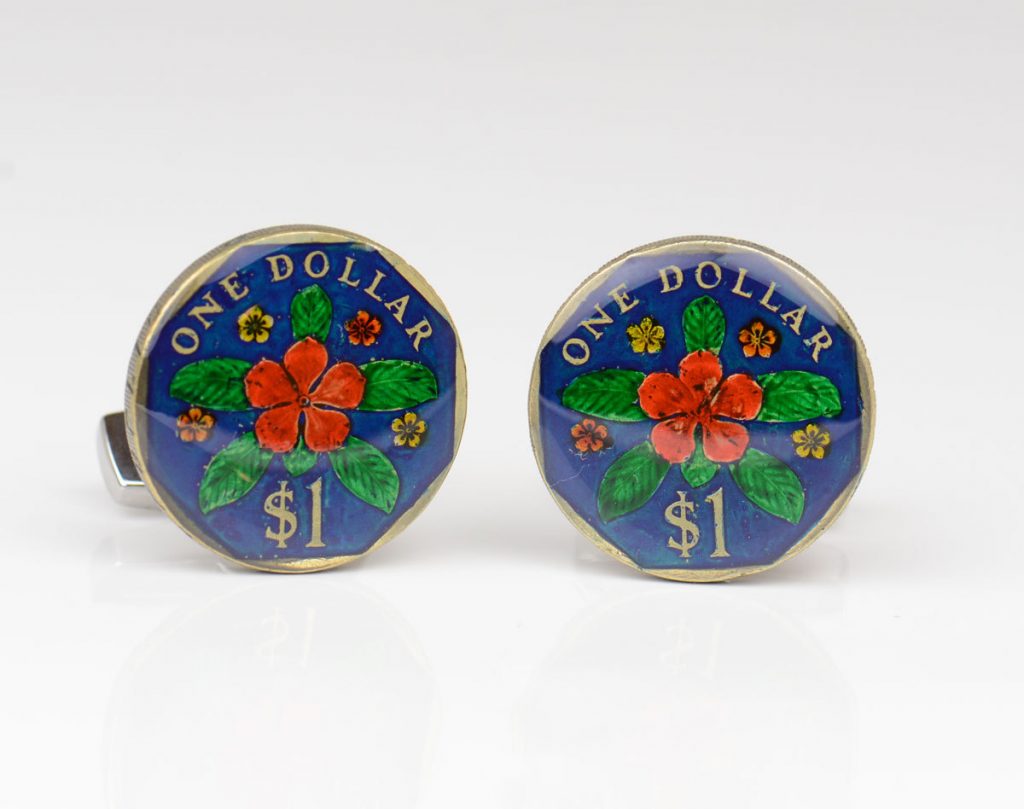
Painted Singapore Dollar coin ring by Monedus
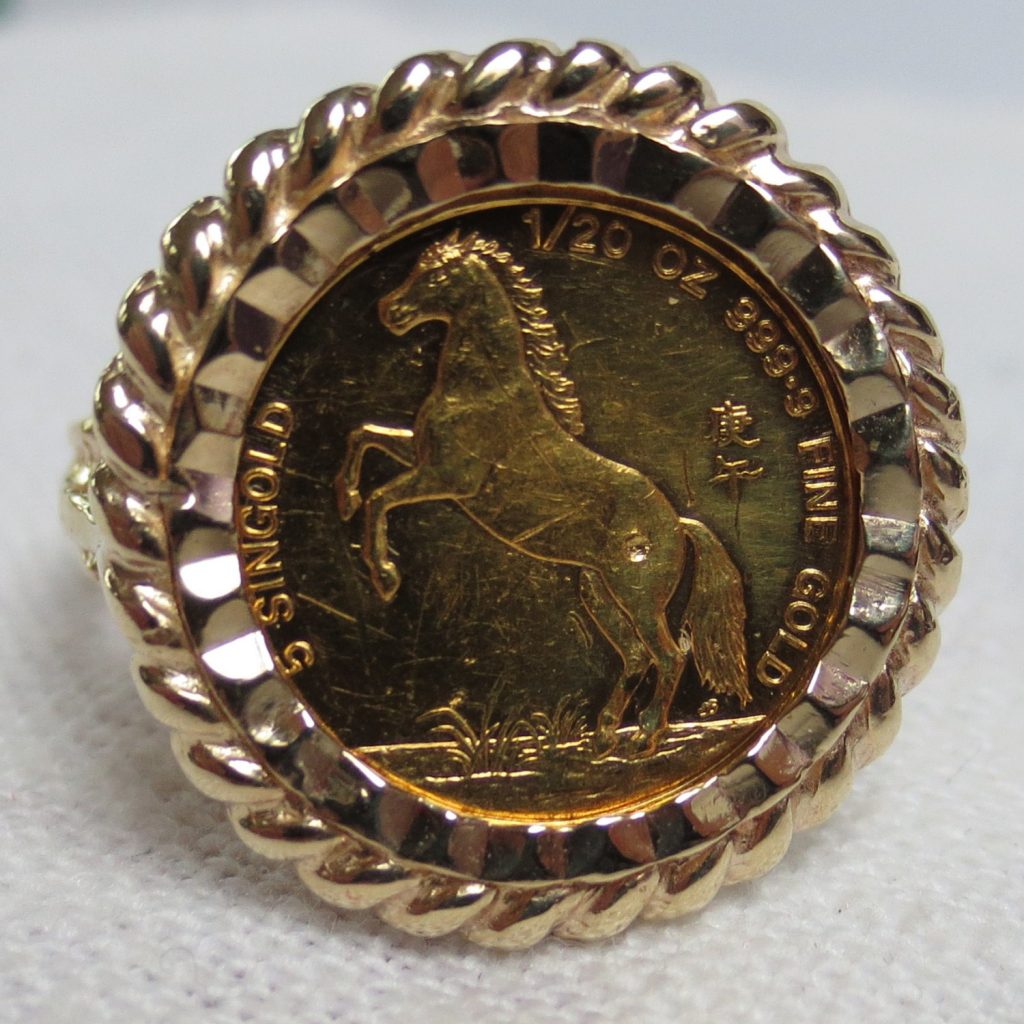
1990 Singapore Horse bullion coin 1/20 oz. in a ring by BritanniaJewelry

Pendant made using a cutout 1979 Singapore coin
Click on the image to visit artist’s store
None of these artists are based on Singapore
While United States law allows for people to use coins for jewelry or other purposes as long as there is no attempt to use them as legal tender currency (18 U.S.C. § 331), this might not be the same for other countries. Although European laws are similar to those in the United States, there is some question as to whether the laws of Canada and Australia can be interpreted to have the same restrictions as Singapore.
When I asked an attorney, he questioned whether an international buyer would convicted of a crime. We both agreed that if you buy jewelry with an international coin, leave it home if you plan to visit that country.
Etsy was asked for a comment but attempts to contact them via email has not been answered.
All images are courtesy of their respective artists on Etsy.
Mar 17, 2016 | cents, coins, commentary, legal, news, US Mint
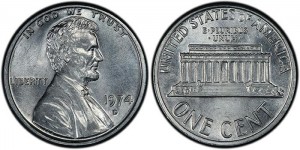
1974-D Experimental Lincoln cent pattern made using an aluminum planchet (J2151)
In 1974, as part of the effort to find a composition that would replace the 95-percent copper planchet for the one-cent coin that was used at the time, the U.S. Mint struck 1.4 million as patterns with the intent on destroying all of the coins struck when completed.
Congress did not like the concept fearing that their silver color would confuse them with other coins. Additionally, the aluminum composition could not be detected in vending machines nor would show up on an x-ray if swallowed. The coins were melted down.
Patterns that were struck for this test were made entirely in Philadelphia.
Which brings us to the story of the 1974-D cent pattern in this story.
Harry Lawrence who retired as deputy superintendent of the Denver Mint in 1979 owned this coin. Lawrence died in 1980. Harry’s son, Randall, discovered the coin in 2013 after moving to La Jolla from Denver and selling a bag of his father’s old coins to Michael McConnell at the La Jolla Coin Shop.
McConnell had the coin graded by Professional Coin Grading Service as MS-63 and determined it to be a genuine pattern. They were going to offer the coin for auction when the government stepped in to stop the sale and demanded its return.
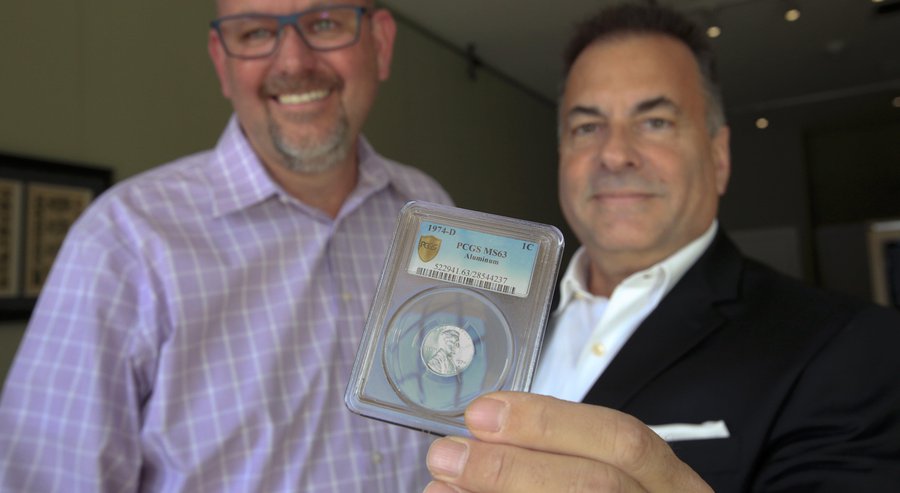
Michael McConnell (left) and Randy Lawrence (right) returned the rare 1974-D penny made from aluminum back to the U.S. Treasury Department Thursday afternoon. — Nelvin C. Cepeda
There is one caveat to this story: there is no record of Denver ever striking such a coin. According to Randy Lawrence, the coin was given to his father when he retired from the Denver mint.
When Lawrence and McConnell sued the government to end the demand order, it is reported that Alan Goldman, former interim Mint director who headed the aluminum cent project, speculated in his deposition that the coin might have been made as part of a practical joke. Goldman allegedly named a suspect whose name was not released but is reported to be deceased.
The ensuing lawsuit lasted about two years and was settled today with McConnell returning the coin to the U.S. Mint on March 17, 2016.
The precedence this ruling is more dangerous for the hobby than people think. The most important issue is that it puts into jeopardy the status of the five 1913 Liberty Head nickels. Created under allegedly similar circumstances, the U.S. Mint has no record that these coins were ever produced. Although the government has tacitly agreed not to pursue that coin, there may be a time when someone with a more parochial view might use this situation to recover alleged chattel as property of the state.
Rulings like this will likely keep any surviving 1964-D Peace dollars hidden from the public. This will partially bury the history of turmoil in the coinage markets of the early 1960s. Hiding history is never good for anyone.
Apr 18, 2015 | coins, gold, legal, news, US Mint
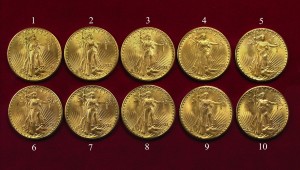
The ten 1933 Saint-Gaudens Double Eagles confiscated by the government from Joan Lanbord, daughter of Israel Switt.
The original suit was filed in the U.S. District Court in Philadelphia by Barry H. Berke on behalf of Joan Langbord, the surviving daughter of jeweler Israel Switt, and her sons Roy and David. Berke is no stranger to these types of law suits. He represented the plaintiffs in the case that resulted in the sale of the Farouk coin in 2002. In July 2011, the jury returned a verdict declaring the coins to be government property.

1974-D Aluminum Cent (J2151)
This case is different since it is further along and about what was to be a circulating coin.
The ruling, written by Judge Marjorie O. Rendell,† centers around the government’s use of Civil Asset Forfeiture Reform Act of 2000 (CAFRA). CAFRA was passed as a “eact[ion] to public outcry over the government’s too-zealous pursuit of civil and criminal forfeiture” and as an “effort to deter government overreaching.” The government said that the Langbords did not file their suit within the 90-day time period. However, the ruling says that it does not imply because “Congress has specifically enumerated theft or embezzlement of government property as one of the crimes to which CAFRA applies.” Since the government called the assets stolen and then ignored the Langbords’ claim for the government to return the coins, they did not prove that the assets were embezzled and CAFRA does not apply.
In the areas where CAFRA did apply, the government did not respond to the Langbords’ request for return of the assets within the 90-days required by law. “The Langbords are correct in urging that we reject these arguments. The Government was required either to return their property or to institute a judicial civil forfeiture proceeding within 90 days of the Langbords’ submission of a seized asset claim.”
The three judge panel concluded “he Langbords are entitled to the return of the Double Eagles.” The appeal overturns the lower court’s ruling and the Appeals Court “will remand for the District Court to order the Government to return the Double Eagles to the Langbords.”
This may not be the end of the story. The government can ask for a temporary stay of the order in order to file an appeal. At that point the government attorneys can either appeal the ruling by the three-judge panel to the full Appellate Court (a full 9 judge panel) or directly to the Supreme Court.
My opinion: considering how the government has behaved throughout the saga of these coins, I think they will try to appeal this ruling to the full Third Circuit. It drags the case out longer and allows the government to put its considerable heft against the the Langbords. I do not think the government will settle this suit in a similar manner that the King Farouk coin was settled. However, if I understand the procedures correctly, the Langbords can claim that the case has significant public interest and ask for it to be heard by the Supreme Court. The Supreme Court then will decide to hear the case or let it be heard by the Third Circuit first. Regardless, I think the next stop is the Supreme Court where the most fascinating story in U.S. numismatics will be settled.
Or will it?
† Judge Rendell was appointed by President Bill Clinton in 1997. She was also the First Lady of Pennsylvania during the term of her then husband
Ed Rendell (2003-2011). The Rendells have since “
amicably separated.”
Image of the 10 Double Eagles courtesy of the U.S. Mint.
Image of the Aluminum cent originally from the Smithsonian Institute.
Jan 10, 2015 | bullion, counterfeit, gold, legal, news, scams
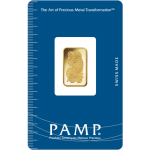
PAMP Gold Ingot
Traveling Suspects Arrested
Two suspects have been arrested for selling fake Suisse Pamp carded gold bars (2.5gm, 5gm,10gm and 1 ounce) at a coin shop in Greenwood, Indiana. Search of the suspects vehicle revealed multiple identification cards, business and pamphlets from different coin shops and an additional 250 fake gold bars and coins. Based upon receipts located in the vehicle the suspects had been selling the fake gold to shops in Illinois, Kentucky, Tennessee and Indiana since September, 2014.
The suspects were driving a silver Ford Focus with Missouri license plates. The suspects are being held for Theft by Deception.
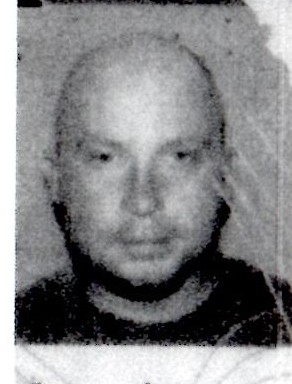
Aaron Taylor
Western Union, IL
Second suspect was identified as Nelson Hernandez (No photo available) alias Benjamin Wade.
Anyone having been in contact with either of these subjects should contact:
Doug Davis, 817-723-7231,
Doug@numismaticcrimes.org
If you have information, please contact Doug Davis. Let’s keep the hobby for both collectors and investors safe!
Sep 8, 2014 | cents, legal, US Mint

Experimental 1974-D Lincoln cent made struck on an aluminum planchet
The argument is over a 1974-D Lincoln cent made of aluminum that was to be auctions by Heritage Auctions during the April 2014 Central States Numismatic Society auction. Rather than being auctioned, the U.S. Mint requested its return as government property even though it was reported that no records of the coin’s production exist.
According to an updated report appearing in Coin World, the coin was given to Harry Lawrence, a former Denver mint assistant superintendent, as part of a retirement gift in 1979. Upon his death, his possession were willed to his son Randall Lawrence.
Randall Lawrence and Michael McConnell, a San Deigo-area dealer working with Lawrence, consigned the coin to Heritage in hopes to be able to donate at least $100,000 from the sale to charities helping the homeless in San Deigo. Heritage had estimated the coin to be worth $250,000. Lawrence and McConnell are asking the federal court to determine the coin’s ownership.
U.S. Mint does not have records of the aluminum cent being struck in Denver. There are records of 1 million coins struck in Philadelphia. Nearly all were destroy.
The U.S. Mint’s mishandling of their own records are legendary. Some of the more famous coins that have escaped official record include the 1933 Saint-Gaudens double eagle and the five 1913 Liberty Head nickels. Numismatic researcher Roger Burdette has documented significant gaps in the way the U.S. Mint has historically mishandled their own documents. Even in recent years, the U.S. Mint has played fast-and-loose even with required documentation during previous director’s term because the narrative of the annual report would make the U.S. Mint’s performance look less than stellar.
Unfortunately for the U.S. Mint, Coin World reporter Paul Gilkes was able to interview former Denver Mint employee Benito Martinez “who said he personally struck fewer than a dozen of these coins as a die setter on aluminum planchets provided by the Philadelphia Mint.” Martinez said that these coins eventually made its way to the U.S. Mint headquarters in Washington, D.C.
Aside from the bad precedent this would create for all pattern coins and trial strikes, this has the potential to undo whatever good will the U.S. Mint has built with the collecting public in the last few years. Problems with the Kennedy gold coin not withstanding, the work that the U.S. Mint has done after the departure of Director Edmund Moy to build a more collector-friendly can be undone by continuing this fight.
Maybe it is time that the lawyers at the U.S. Mint and the Department of the Treasury stop trying to flex its muscles and realize the goodwill that would be created by changing policies and attitudes. After all, like all lawyers it is possible to interpret the law in a manner that would be more helpful while protecting the U.S. Mint and the U.S. government.
Image courtesy of Coin World.
Mar 21, 2014 | coins, commentary, eBay, legal
 The Ninth Circuit Court of Appeals upheld the dismissal of the antitrust class action suit against eBay for its policy for listing certified coins for sale.
The Ninth Circuit Court of Appeals upheld the dismissal of the antitrust class action suit against eBay for its policy for listing certified coins for sale.
The story begins in 2007 when eBay began to set standards for listing coins on its site. As part of its decision as to which coins could be listed as graded with their grade as part of the listing, the policy was created that grading services had to have been rated good or better in the 2006 Grading Services Survey performed by Professional Numismatic Guild and Industry Council for Tangible Assets.
After a lot of protest from the numismatic community, by 2008, eBay changed their policy for listing coins to require coins worth more than $2,500 to be graded and listings that mention grades be graded by an approved grading service. To become an approved grading service the company has had to grade 50,000 pre-1956 coins, provides an online population report, has three professional graders on staff with at least one a member of the Professional Numismatic Guild, provide a written guarantee, encase coins in a tamper resistant holder with anti-counterfeiting measures, and provide an online serial number verification service.
Initially, only coins graded by Numismatic Guarantee Corporation and Professional Coin Grading Service qualified under these rules. Shortly before the ruling was to take effect, ANACS and Independent Coin Graders make the necessary adjustments to have coins in their holders qualify for listing as graded on eBay.
Universal Grading Service (UGS) was a nascent New Jersey-based grading service decided to file an antitrust suit eBay, the American Numismatic Association, then ANA President Barry Stuppler, and PNG claiming that the rules are preventing them from competing in the market. Their claim was that coins in their holders were allegedly banned by eBay claiming that by using the study, eBay was in collusion with the ANA and PNG to prevent them from participating in the market, an alleged violation of the Sherman Antitrust Act.
UGS initially filed the anti-trust case in the Eastern District of New York. The court, based in Brooklyn, determined that since eBay was the lead defendant and the service most impacted by the suit, New York was not the proper jurisdiction. The court ordered that the case be transferred to Northern District of California.
The case was move to the San Jose Division for the Northern District of California and assigned to Judge Ronald M. Whyte. In mid-2011, Judge Whyte granted motions (with prejudice) to dismiss the case against the ANA, PNG, and Barry Stuppler. That left only eBay as the lone defendant.
On January 9, 2012, Judge Whyte granted eBay’s motion to dismiss the case with prejudice. Judge Whyte noted that the case was flawed from the beginning and gave UGS every opportunity over two years to amend the case in order to prove their claim. Judge Whyte agreed with eBay that USG did not provide evidence that eBay violated the Sherman Antitrust Act or other associated laws.
UGS appealed to the Ninth Circuit Court of Appeals saying that Judge Whyte wrongly dismissed the claim and that they met their filing responsibility under the Sherman Antitrust Act and associated state laws. The three judge panel affirmed the Judge Whyte ruled properly and let the dismissal stand.
UGS, who has ceased operations, can appeal the case to the full Ninth Circuit asking for a review. When appealing a ruling to a full circuit court panel, all nine judges assigned to that circuit, including the members of the three-judge appellate panel, will hear the appeal. An attorney familiar with Federal Circuit Courts said that it is rare that a dismissal by a federal district judge that is upheld by an appeals panel will be selected to be heard by the full circuit. He did note that stranger things have come out of the Ninth Circuit and it could be possible that they would hear the case.
After the Ninth Circuit, the next step would the Supreme Court. Sources report that if the full Ninth Circuit refuses to hear the case or the dismissal is upheld, “there is no attorney in his right mind” that would file an appeal to the Supreme Court after two courts uphold a dismissal.
With this ruling, the Universal Grading Service is effectively dead and buried. Whatever the people behind UGS were hoping to get out of this case will not be realized.
One thing this ruling says is that the cost to entry the coin grading market is very high. The court affirmed that eBay can set the market rules and as one of the dominating venues for selling coins, a new grading service would have to meet eBay’s requirements in order to gain market acceptance. The difficult benchmark is to have graded 50,000 pre-1956 coins.
There appears no reason why pre-1956 was picked as the dividing line. For many, it would make sense to select pre-1965 to include all coins that are pre-clad coinage. Calls to eBay to obtain clarification about the policy have not been returned. Since eBay consulted with John Albanese, principal of Numismatic Consumer Alliance and Certified Acceptance Corporation (CAC), contacting him may be an option.
Interestingly, if eBay is to follow its policy to the letter, coins that received verification stickers from the CAC cannot be listed as part of the grade. Titles should not be allowed to indicate that the coins have been verified by CAC nor should the description. As far as I am concerned it would be acceptable for eBay to ban the designation of CAC verification as I am not a fan of the service.
Which raises a thought: considering the CAC’s business model includes only coins certified by NGC and PCGS, and given Albanese’s past associations with both of those services, if the case was limited to eBay and Albanese/CAC would it have been more successful?
Sep 26, 2013 | ancient, coins, commentary, foreign, legal
 Fred and Wilma (not their real names) are friends who decided to celebrate their empty nest by taking a trip to the Mediterranean after dropping their youngest child off at college. Fred is what I respectfully call a hacker. He is a wizard programming computers and someone who I go to in order to understand some of the more esoteric aspects of computer exploits he researches. In his spare time, Fred plays with his computers and tinkers with electronics. Fred is also known as an overgrown boy scout. He is contentious about his work, children, and the activities he is involved with. Fred is probably the most honest person I know.
Fred and Wilma (not their real names) are friends who decided to celebrate their empty nest by taking a trip to the Mediterranean after dropping their youngest child off at college. Fred is what I respectfully call a hacker. He is a wizard programming computers and someone who I go to in order to understand some of the more esoteric aspects of computer exploits he researches. In his spare time, Fred plays with his computers and tinkers with electronics. Fred is also known as an overgrown boy scout. He is contentious about his work, children, and the activities he is involved with. Fred is probably the most honest person I know.
Fred is not a coin collector and has no interest in collecting coins even though he does own the 2004 Thomas Edison commemorative coin and the 2005 Albert Einstein 2 Shekel proof coin from Israel because these are two people he admires. On many occasions, Fred has said that he did not understand what I saw in collecting coins. Even after showing him my original Lincoln cent folder with coins I have found in change dating back to when I started collecting, he did not understand the lure of the chase.
While sitting on a beach along the Mediterranean, Wilma started to dig in the sand around a sleeping Fred to have fun at his expense. After she dug nearly two feet down, Wilma unearthed metal object that she originally thought was trash. After waking Fred and watching him roll into her newly dug hole, Fred brushed himself off and looked at what she found. A trip to the water to rinse off the items to find three ancient coins and a shell. The way it was described to me was that the coins were sitting in the shell as if it were a change holder. They dug some more and found three more coins. To some degree, he began to understand the thrill of the chase.
With the help of the hotel concierge, Fred and Wilma found a coin dealer who spoke English to ask about the coins. After talking with the dealer they found that the coins were common and would only be worth the equivalent of a few dollars. Undeterred, the coins were placed in a small bag and throw in the bottom of their carry on luggage as souvenirs and continued with their vacation.
A few days later, Fred and Wilma packed their bags and went to the airport to return home. At their host country’s departure screening, Fred was asked if there was anything to declare. Fred, being an overgrown boy scout, declared everything—even things he did not have to declare. As the officers were inspecting the items on the table, one picked up the bag with the coins and asked about coins. Fred showed the officer the written estimate from the dealer thinking that would resolve any issue.
According to Fred, the officer took coins and the estimate to another officer he described as having more decorations on his uniform. This higher ranking officer looked at the coins and paper while discussing the situation in their native language. After a moment, Fred became concerned and Wilma became nervous.
Another officer walked over with the higher ranking officer and acted as a translator as it was explained to Fred that the coins were “cultural antiquities” and would be confiscated. Fred was not happy but he accepted the situation until the translator said that Fred and Wilma would be detained while the officials investigated. They were allowed to gather their luggage and were escorted to a nearby room.
After waiting for an hour, another official came into the room and spoke to Fred and Wilma in English. Fred explained how he obtained the coins and why he was taking them home. After the official started questioning them as if they were criminals Fred asked to speak with the United States Embassy.
Fred and Wilma were escorted by local police to two separate facilities to be incarcerated pending an investigation. The facilities were in separate parts of town since these were not co-ed accommodations. They waited two days before seeing anyone other than the guards.
Two days later, both were escorted to a local judge and said they were being charged with trying to smuggle antiquities out of the country. An attorney was appointed to represent them. The attorney did not speak English and only wanted them to plead guilty for a three-year sentence. Thankfully, there was an American in the courtroom who told the attorney that he would contact the U.S. Embassy and not to plead on the case.
The next day, someone from the Embassy was able to have Fred and Wilma released to their custody, recovered their luggage, and let them stay in the embassy while trying to resolve the situation.
Obviously, the embassy accommodations were better than what they had at the local jail. Fred described the embassy staff as very nice including the natives who worked non-diplomatic jobs. Unfortunately, they could not leave the embassy since they were technically under house arrest. Although it was a gilded cage it was still a cage.
It took nine days to resolve the issue which Fred was told was lightning speed for that country. The coins were left in the country they were visiting, which Fred offered to do at the airport when confronted by the officials. They were driven to the airport by a U.S. military driver and escorted to the screening area by a member of the diplomatic staff who ensured their passports were returned and that they were allowed to board the plane.
The plane landed in a more friendly country where Fred and Wilma were met by local and U.S. officials for a debrief. Although the debrief was friendly, it did come after a stressful period in another country and lasted a few hours. Eight hours after landing in London, Fred and Wilma was en route back to the United States.
The country where this incident occurred is allegedly friendly with the United States but that did not stop the officials at the airport from treating them with suspicion over the possession of a few common ancient coins. Based on Fred’s description of the coins, I asked a dealer who said that $20 would be an average retail price for the coins. When asked if Fred wanted to buy similar coins, Fred could not decline fast enough!
I have written several posts about the impact of the Convention on Cultural Property Implementation Act (CPIA; 19 U.S.C. §§ 2601 et seq.) and the potential for foreign countries to use Memoranda of Understanding that the State Department’s Cultural Property Advisory Committee (CPAC) agrees to without considering citizen comments. The CPAC has said that the collateral issues raised by the comments are baseless. Fred can tell them otherwise.
Fred said that the embassy would not answer questions about what happened. Neither did the government officials during their layover in Europe. He was told that they should be thankful that this “only” lasted two weeks because it could have taken two months or even two years to resolve.
Next time the Ancient Coin Collectors Guild (ACCG) asks for assistance in addressing a call for comments from the CPAC regarding a foreign country’s MOU request, please remember the plight of Fred and Wilma. Although their ordeal lasted “only” two weeks, the next person may not be as lucky and find themselves in the jail of a country whose laws are far less humane than the United States.
Image of the ancient coins courtesy of
NGC. These are
not the coins the story is about.
Jun 5, 2013 | ANA, commentary, legal
I know I have not been writing a lot as of late. Those of us in the Washington, D.C. area know the problems that sequestration has caused on government agencies. It might take another month before we regain a rhythm that will allow me to plan my time better. I have a nice To-Do list of stories I want to post including four book reviews and a few iPhone apps that are interesting.
I also do not want to use this blog as a campaign vehicle because that would be boring for you to read and for me to write. But when something as big as the most recent news comes out and I am asked for a comment, I have no choice but to use this blog to answer the many email inquiries once so we can get on with life.

Contemplation of Justice by James Earle Fraser, outside of the U.S. Supreme Court, Washington, DC
The amended complaint is shocking and salacious. For those not familiar with the law and read that Shepherd is accusing the ANA of being a Racketeer Influenced and Corrupt Organization (RICO; 18 U.S.C. Chapter 96), it makes it look like the ANA is being compared to any number of organized crime figures you might have read about in the newspapers. Even though the RICO statutes were written to fight organized crime, using it is a common tactic by plaintiff lawyers to scare the defendants they are suing.
In order for a RICO charge to be accepted by the court, Shepherd and his lawyers will have to prove that a person as a member of an enterprise or the enterprise itself has committed to of 35 different crimes (18 U.S.C. § 1961). The crimes that Shepherd is alleging that the ANA has committed are racketeering, theft, and fraud.
Racketeering sounds like an ominous charge. Racketeering is a crime when two or more people conspire to fraudulently solve a problem. Shepherd alleges that a few employees of the ANA and members of the Board of Governors made up stories about Shepherd in order to find a way to relieve him of his duties for cause so they can invalidate his contract. The stories are salacious in nature and constitute Shepherd’s accusation of defamation that allows him to attach others to the case to show that there were more than two people involved.
The theft charge is from the guilty plea by former collections manager Wyatt Yeager. In January 2012, Yeager plead guilty to stealing items from the ANA Money Museum worth nearly $1 million. Yeager was sentenced to 27 months in a federal prison, two years of supervised probation, and ordered to pay restitution to the ANA.
With the theft charges already verified by a criminal court, Shepherd has to prove that the ANA committed fraud and at least two of the co-defendants conspired to fraudulently have him dismissed to resolve whatever issues the co-defendants perceived hurt the ANA. That would prove the case under RICO and hold the co-defendants and the ANA liable for Shepherd’s dismissal.
If you decide to read the pleading please remember that it is one side of the story. While the accusations are salacious and disturbing, we have not heard from the ANA or the co-defendants. This is a stark contrast to how they handled Shepherd’s dismissal when they could not stop talking. However, the ANA has a new general counsel who may be a little more cautious than the previous general counsel. The previous general counsel, Ron Sirna, is a co-defendant on this lawsuit.
Shepherd’s charges against the ANA and the co-defendants are disturbing. In fact, the nature of the salacious accusations is disturbing. If there is any truth in these accusations, those involved must be disciplined. Employees involved should be required to undergo remediation to keep their jobs or be dismissed if their action crossed the legal line.
According to the ANA Code of Ethics, members are required to “To base all of my dealings on the highest plane of justice, fairness and morality, and to refrain from making false statements as to the condition of a coin or as to any other matter.” Any member found to have be part of the racketeering that Shepherd’s lawsuit alleges, should be subject to an ethics review.
I was recently reminded of a quote from Inferno, the first part of Dante Alighieri’s epic poem The Devine Comedy: “The darkest places in hell are reserved for those who maintain their neutrality in times of moral crisis.” Therefore, members of the Board of Governors who did not “report any knowledge of waste, fraud, corruption or impropriety relating to the Association to all other Board members immediately upon learning thereof” (Code of Ethics, Section 12) should also be subject to an ethics review.
Shepherd is also not absolved from his part. While he may have a legitimate case, his timing is suspect. Why did he wait until the beginning of the election to amend his complaint laced with descriptions of salacious accusations at this time? Shepherd has to remember that while he makes accusations, it takes two to tango, which means that he may have had a part in acts that the pleading describes. It is also possible that Shepherd and his attorneys picked only examples that are in his favor. Until the ANA answers the charges levied by Shepherd we are left wondering what was left out?
The bottom line is that it is time to clean house. ANA members must elect a Board of Governors that will act more like a Board of Directors. People who will be professional, open, and work for the benefit of the ANA. The Board of Governors must treat the association like the $6 million business it is and set up programs for the professional office to support the association for the benefit of the members and not the benefit of the staff. While there may be a few people with issues, as described in Shepherd’s pleading, those few people are making the situation difficult for those who are doing a wonderful job.
If I am privileged to receive enough votes to be elected to the Board of Governors, I renew the promise I made previously that the first motion I will make will be to hire an executive management firm that has a verifiable background in helping non-profit organizations to review the entire ANA management structure. This stuff has to stop so that we can get on with the business of building our collections with all of the advantages the ANA can provide us, the members.
Image from Photographs from the Supreme Court’s Collection.
Jan 6, 2013 | bullion, coins, commentary, Eagles, gold, legal, platinum, policy

Obverse of the 2012 American Eagle Platinum Proof
Regardless of the side of the political spectrum you are in this topic, it will not work.
The United States Code (U.S.C.) is the codification of the laws of the United States. It is divided into 51 titles each covering one general topic. References to the law are made by providing the title number, followed by “U.S.C.,” then the section of the law. Subsections are added using parentheses after the section. All of the laws governing the U.S. Mint are under Title 31. When talking about what coins the U.S. Mint may be allowed to strike, you would find those laws in Title 31 Section 5112 (
31 U.S.C. §5112).
First question is whether it is legal for the U.S. Mint to strike the $1 Trillion coin. Although there are as many answers as there are pundits, everyone points Title 31, Section 5112, paragraph “k” (31 U.S.C. § 5112(k)) that reads as follows:
The Secretary may mint and issue platinum bullion coins and proof platinum coins in accordance with such specifications, designs, varieties, quantities, denominations, and inscriptions as the Secretary, in the Secretary’s discretion, may prescribe from time to time.
This law was passed by congress under their authority in Article 1, Section 8 of the U.S. Constitution that says “The Congress shall have Power… To coin Money, regulate the Value thereof, ….” The law’s intent was to give the U.S. Mint the authority to issue the American Eagle Platinum Bullion and Platinum Proof coins. American Eagle Platinum coins have a $100 face value and sell for a premium over the market price of platinum and taking into consideration coin’s production cost. However, the law does not restrict the issuance of the platinum coin to the American Eagle program.
But is it constitutional? The argument from John Carney of CNBC says it is not by twisting a ruling by the Supreme Court. Carney cites the case Whitman v. American Trucking Assns., Inc. (531 U.S. 457 (2001)) in saying that “the Environmental Protection Agency rule making authority was too broad because Congress had failed to provide ‘intelligible principle’ to guide the agency.” Unfortunately, like a lot of people, Carney reads the headlines and not the majority opinion. In the majority opinion, Justice Antonin Scalia wrote the law “does not permit the Administrator [of the EPA] to consider implementation costs” which is against previous precedent because the Clean Air Act, which was under question, “often expressly grants the EPA the authority to consider implementation costs, a provision for costs will not be inferred from its ambiguous provision.”
In other words, the Supreme Court said that because there are conflicts in the law. The “intelligible principle” is that Congress cannot delegate partial authority over one part of a law where other parts have a requirement to consider other circumstances. In other words, the Supreme Court is saying that Congress has to be consistent in delegating its authority.
Could 31 U.S.C. § 5112(k) be interpreted in the same manner? It is possible for the Supreme Court to declare the law unconstitutional, but if they do so they would also have to rule that the law that allowed the U.S. Mint to create the 2009 Ultra High Relief Gold Coin unconstitutional. According to 31 U.S.C. § 5112(i)(4)(C):
… at the same time the Secretary in minting and issuing other bullion and proof gold coins under this subsection in accordance with such program procedures and coin specifications, designs, varieties, quantities, denominations, and inscriptions as the Secretary, in the Secretary’s discretion, may prescribe from time to time.
Under both 31 U.S.C. § 5112(k) and 31 U.S.C. § 5112(i)(4)(C), the Secretary can authorize the U.S. Mint to strike any denomination platinum or gold coin with the value of $1 Trillion. Since there is no ambiguity or contradictions that would be able to use Whitman v. American Trucking Assns. as a precedence, the constitutionality should not be in question.
If the Secretary could mint and issue a $1 Trillion coin, then the Secretary could mint 17 such coins that could theoretically be used to pay off the country’s debt and give the country a positive balance for the first (and only) time since 1835 under President Andrew Jackson.
For discussion sake, let us say that the Secretary authorized the U.S. Mint to produce a $1 Trillion coin. Who is going to buy the coin?
If the concept is to use the profit (seigniorage) from the sale of the coin, whether it is made of gold or platinum, the coin has to be sold in order for there to be a profit. If the government would just deposit a $1 Trillion coin in the Federal Reserve, then where is the profit for the government? In order for a coin to become legal tender, it has to be bought from the government for at least its face value unless the law allows otherwise (see the American Eagle Bullion program and any of the commemorative programs). The U.S. Mint does not consider a coin to be legal tender until it receives an appropriate deposit of bullion or other forms of legal tender.
It this concept of legal tender that has been behind the government’s position that because the 1933 Saint-Gaudens Double Eagle coin was not paid for by a depositor (part of which is required in 31 U.S.C. § 5122), they are government owned coins (31 U.S.C. § 5121) and not legal tender. This concept has been upheld in the history of the 1933 Saint-Gaudens Double Eagles including the settlement over the Fenton-Farouk coin that sold for $7,590,020 with $20 going to “monetize” the coin.
Most recently, Judge Legrome D. Davis (U.S. District Court for Eastern Pennsylvania) confirmed the legal tender status of the 10 Double Eagles that Joan Langbord allegedly found in a box once owned by her father, infamous Philadelphia jeweler Israel Switt who is considered one of the central figures in the coins removal from the U.S. Mint. In Lanbord et al v. U.S. Treasury (Civil Action No. 06-5315), Judge Davis’s opinion cites past cases including the government’s own case against Israel Switt in 1934 for not forfeiting recalled gold and the previous return of 75 coins attributed to him. His opinion effectively confirms the U.S. Mint’s argument that once it creates a coin it is not legal tender and a liability on their balance sheet until the coins is bought.
If the coin is has to be paid for by a depositor before it can become legal tender, who will buy a $1 Trillion coin?
If the coin is just deposited with the Federal Reserve, there will be a $1 Trillion liability on the government’s balance sheet. In order to make the books balance, the Department of Treasury would have to sell debt bonds to make up the difference and that would add $1 Trillion to the national debt.
If the coin is bought by the Federal Reserve, then the Fed will have to pay $1 Trillion to the U.S. Mint for the coin reducing its overall working capital by $1 Trillion. Paying for a $1 Trillion that could not be used will just transfer the debt from the general treasury to the Federal Reserve. Since the Federal Reserve is in charge of managing the country’s money supply, the net effect will be to reduce the money supply by $1 Trillion that will cause the economy to shrink—any time you artificially remove money from the economy it will shrink which will also weaken the buying power of the U.S. dollar.
Transferring the debt away from the general fund might look good on paper but the effect will shrink the economy and cause more problems than even considering the constitutionality of doing this.
Unfortunately, this scheme was conjured by someone who did not think through the idea thoroughly.
Coin image courtesy of the U.S. Mint.
Dec 20, 2012 | ANA, commentary, legal, news
 We knew it was coming. The American Numismatic Association issued a press release saying that they are being sued by former Executive Director Larry Shepherd.
We knew it was coming. The American Numismatic Association issued a press release saying that they are being sued by former Executive Director Larry Shepherd.
“There is no merit to any of the allegations contained in the lawsuit, and it will be vigorously defended,” read the press release. “he ANA will make no further comment with regard to this pending litigation.”
This saga started on August 23, 2011 when the ANA announced that Shepherd was placed on administrative leave. After a month of speculation on why the ANA took this action, it was announced on September 28, 2011 that the ANA had “ended its employment arrangement with Larry Shepherd, as executive director, effective as of September 20, 2011. the vote of the Board to sever that relationship was unanimous.”
Obviously, Shepherd did not take it well and issued a statement about his firing when the ANA responded but should not have. All has been quiet until a the Shepherd filed suit for wrongful termination.
This will make two dismissed executive directors who have sued the ANA. Even if the ANA wins their argument, the ANA loses because of the costs to defend itself. Just as the ANA was getting its financial footing back together, here is a potentially large, unexpected expense that has to be dealt with.
If the “third time’s a charm,” then the ANA has done well by hiring Jeff Shevlin. After meeting Jeff, I believe he really has the best interest of the ANA at heart and will do a great job.













 The
The 



